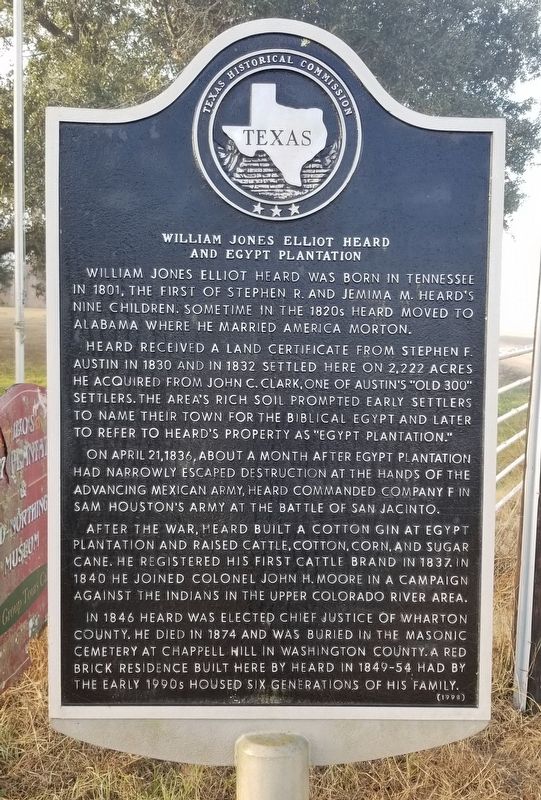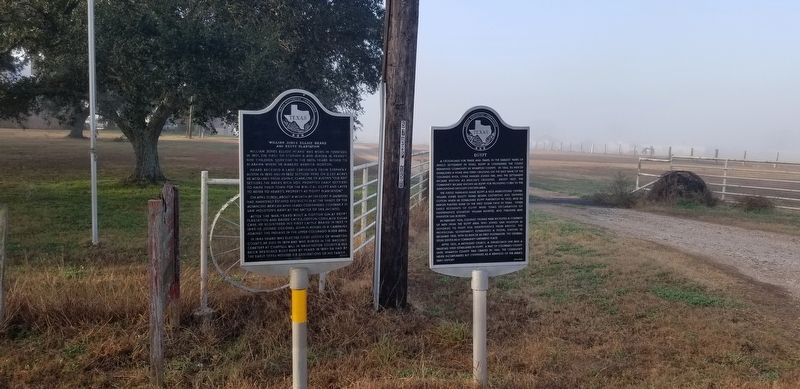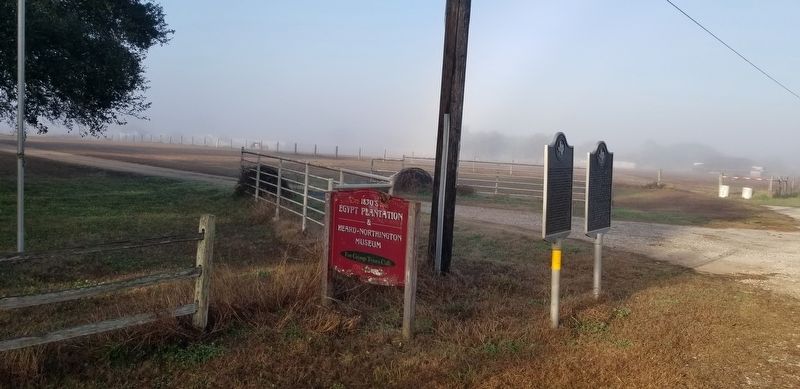Egypt in Wharton County, Texas — The American South (West South Central)
William Jones Elliot Heard and Egypt Plantation
Inscription.
William Jones Elliott Heard was born in Tennessee in 1801, the first of Stephen R. and Jemima M. Heard's nine children. Sometime in the 1820s Heard moved to Alabama where he married America Morton.
Heard received a land certificate from Stephen F. Austin in 1830 and in 1832 settled here on 2,222 acres he acquired from John C. Clark, one of Austin's "Old 300" settlers. The area's rich soil prompted early settlers to name their town for the biblical Egypt and later to refer to Heard's property as "Egypt Plantation."
On April 21, 1836, about a month after Egypt Plantation had narrowly escaped destruction at the hands of the advancing Mexican Army, Heard commanded Company F in Sam Houston's Army at the Battle of San Jacinto.
After the war, Heard built a cotton gin at Egypt Plantation and raised cattle, cotton, corn, and sugar cane. He registered his first cattle brand in 1837. In 1840 he joined Colonel John H. Moore in a campaign against the Indians in the upper Colorado river area.
In 1846 Heard was elected Chief Justice of Wharton County. He died in 1874 and was buried in the Masonic Cemetery at Chappell Hill in Washington County. A red brick residence built here by Heard in 1849-54 had by the early 1990s housed six generations of his family.
Erected 1994 by Texas Historical Commission. (Marker Number 5834.)
Topics. This historical marker is listed in these topic lists: Animals • Industry & Commerce • Settlements & Settlers • War, Texas Independence. A significant historical date for this entry is April 21, 1836.
Location. 29° 24.227′ N, 96° 14.009′ W. Marker is in Egypt, Texas, in Wharton County. Marker is on Farm to Market Road 1161, 0.4 miles east of Farm to Market Road 102, on the right when traveling east. The marker is located at the entrance to the old Egypt Plantation at the highway. Touch for map. Marker is in this post office area: Egypt TX 77436, United States of America. Touch for directions.
Other nearby markers. At least 8 other markers are within 10 miles of this marker, measured as the crow flies. Egypt (here, next to this marker); Camp Zion Missionary Baptist Church (approx. 2 miles away); Joseph and Rachel Rabb Newman (approx. 3.2 miles away); Glen Flora (approx. 4.6 miles away); Frazarville (approx. 7½ miles away); Nada (approx. 9 miles away); Nada Post Office (approx. 9.2 miles away); Site of Post West Bernard Station (approx. 9.4 miles away).
More about this marker. While the historical markers can be viewed from the road, the Egypt Plantation and cemetery are located on private property. It does require approval from the owners of the Egypt Plantation Museum for access to visit.
See the link.
Also see . . . Heard, William Jones Elliott (1801–1874). Texas State Historical Association website entry:
When Mexican general Adrián Woll invaded Texas in 1842, Heard raised a company of twenty volunteers and was assigned to the command of the defense of Victoria. He arrived there on the evening of March 6 to find "the citizens badly armed and in great confusion." Upon receiving reports that a force of 1,100 of the enemy were marching toward Victoria from Refugio and that 3,000 more were near San Antonio, with an additional 14,000 reinforcements still beyond the Rio Grande, he wrote to the editor of the Telegraph and Texas Register, "I have no doubt, from all I can gather that there is an invasion at hand," and resolved to fall back beyond the Lavaca River the following day. "I cannot risk myself and men here longer than tomorrow evening without help," he wrote. After Woll's withdrawal, however, Heard and his men returned to their homes. Source: The Handbook of Texas(Submitted on February 11, 2022, by James Hulse of Medina, Texas.)
Credits. This page was last revised on June 21, 2023. It was originally submitted on February 11, 2022, by James Hulse of Medina, Texas. This page has been viewed 329 times since then and 50 times this year. Photos: 1, 2, 3. submitted on February 12, 2022, by James Hulse of Medina, Texas.


